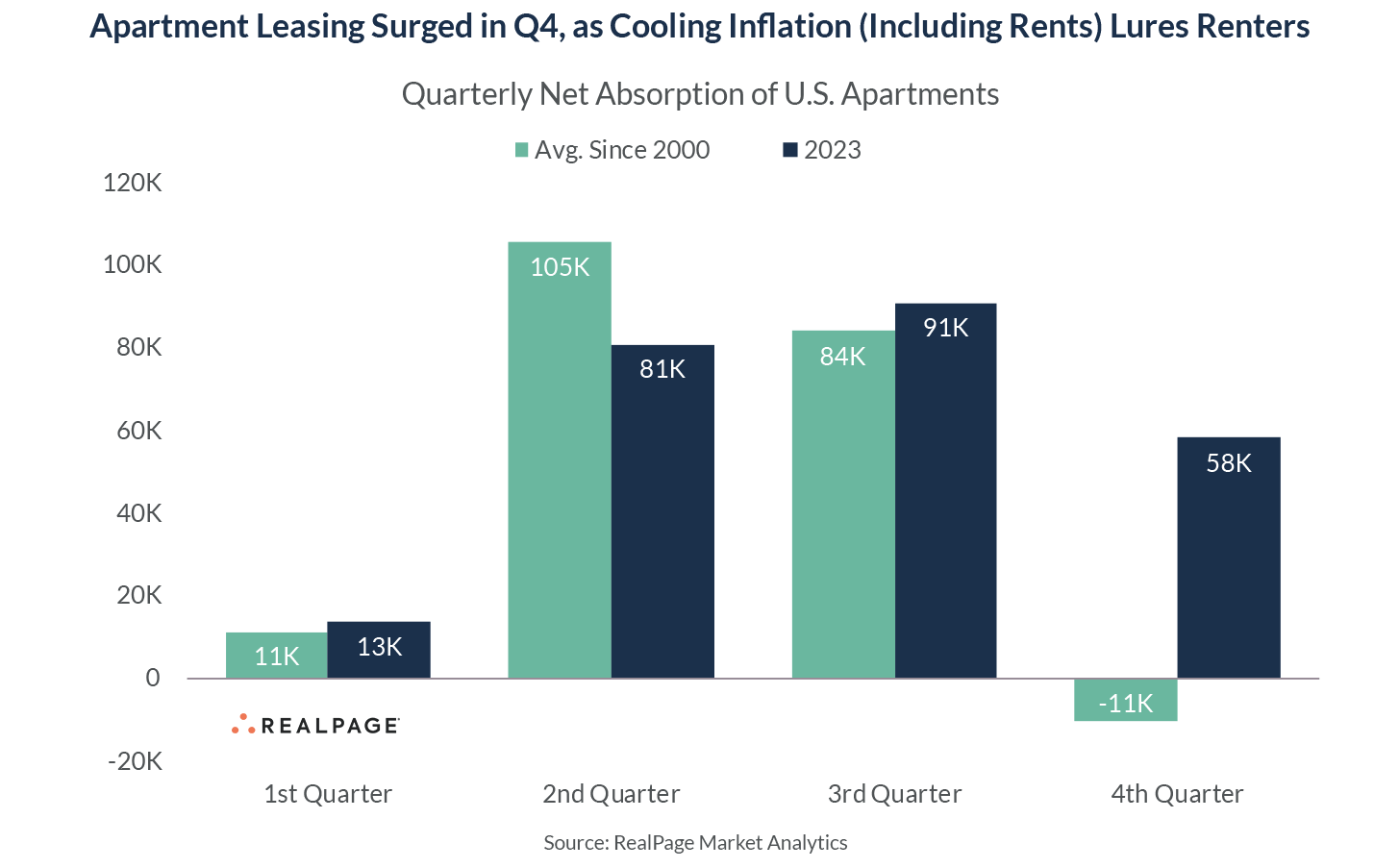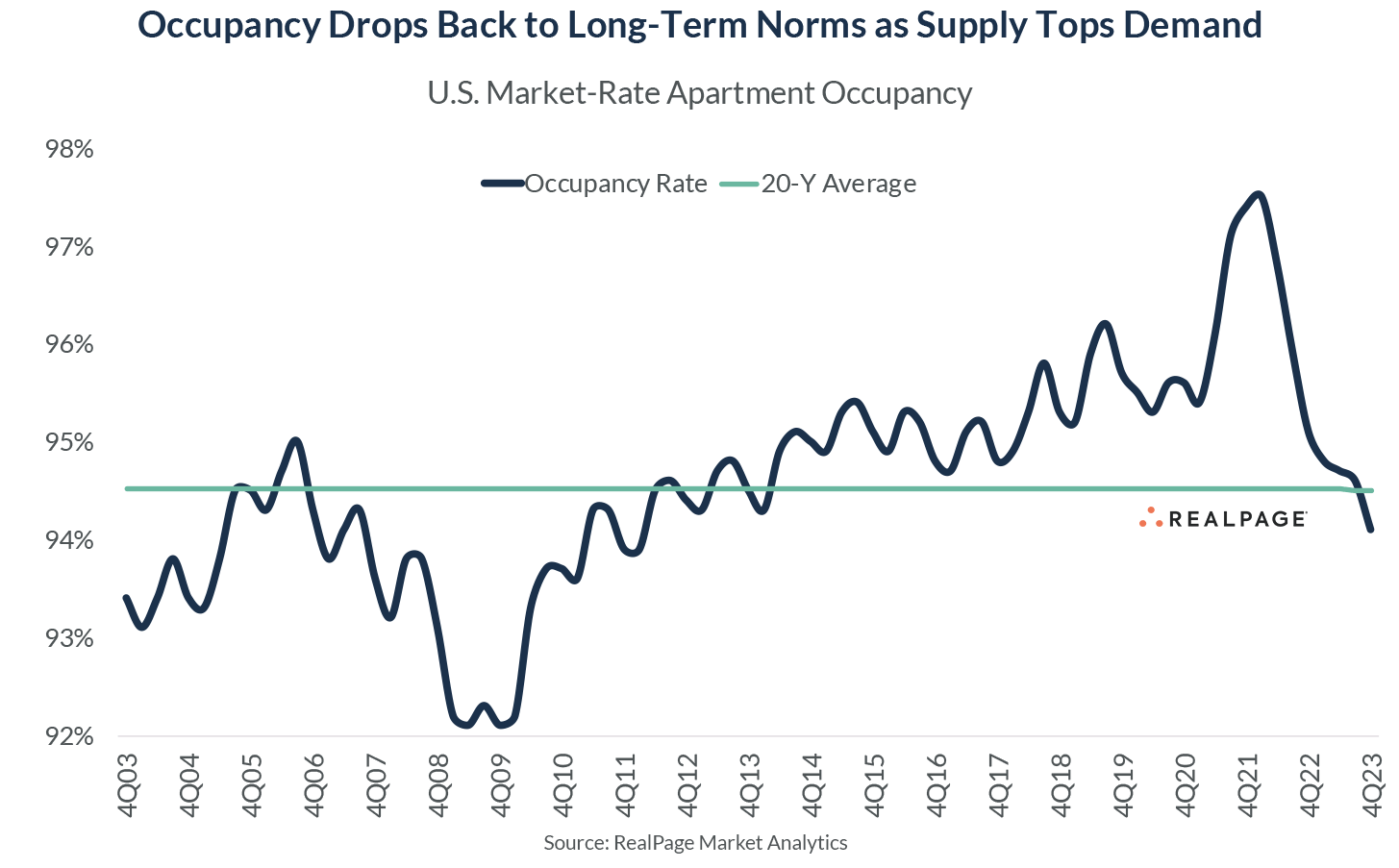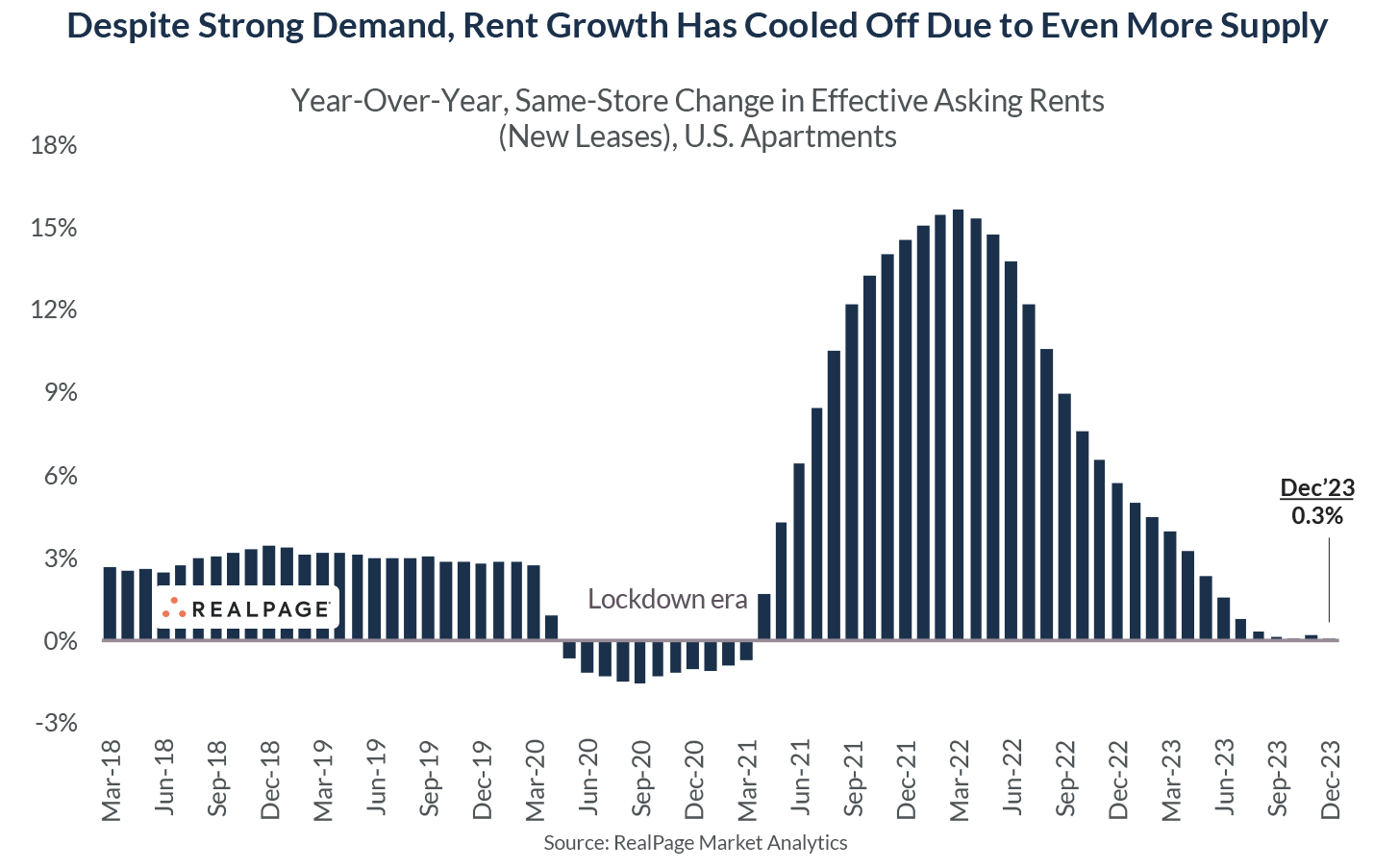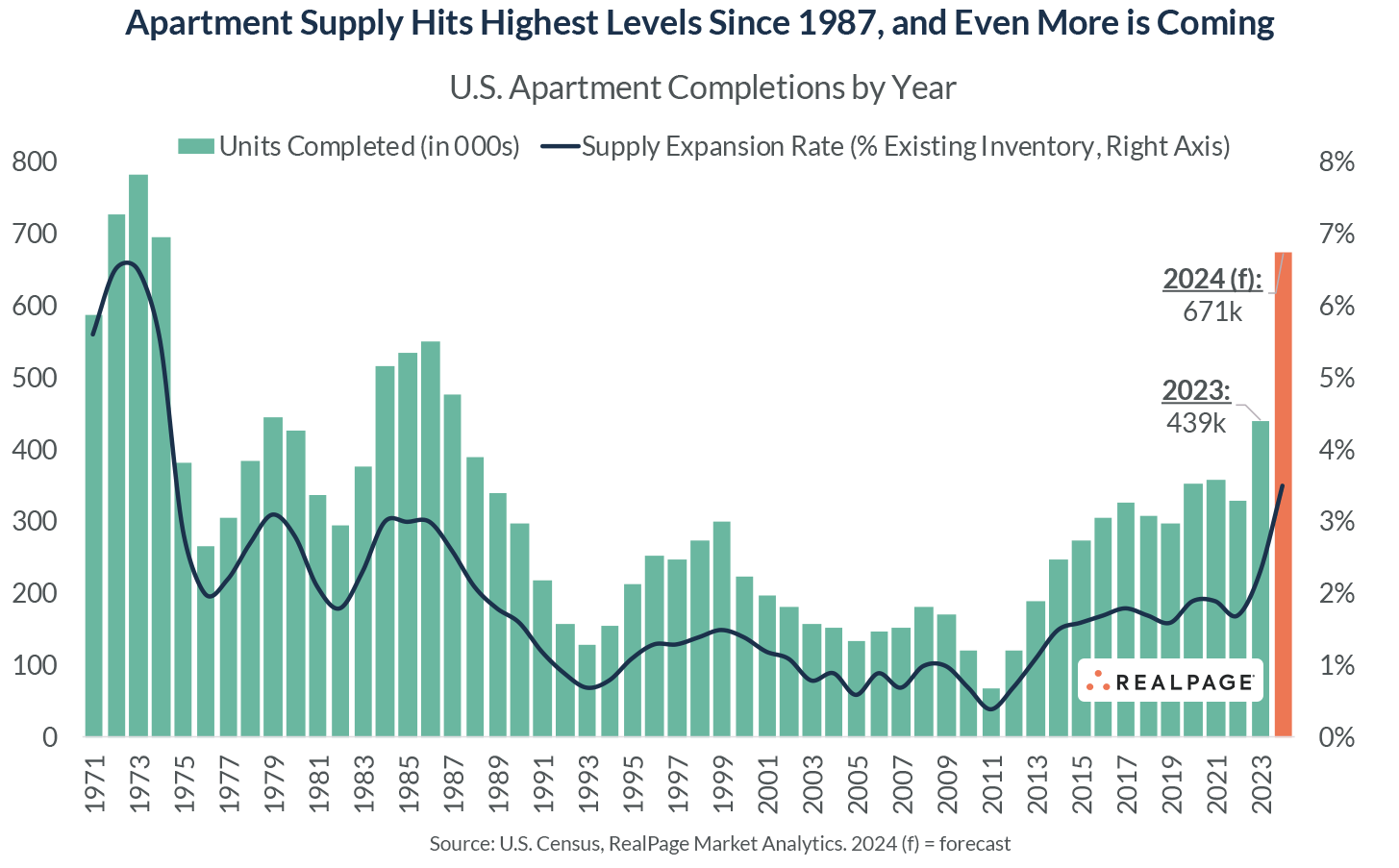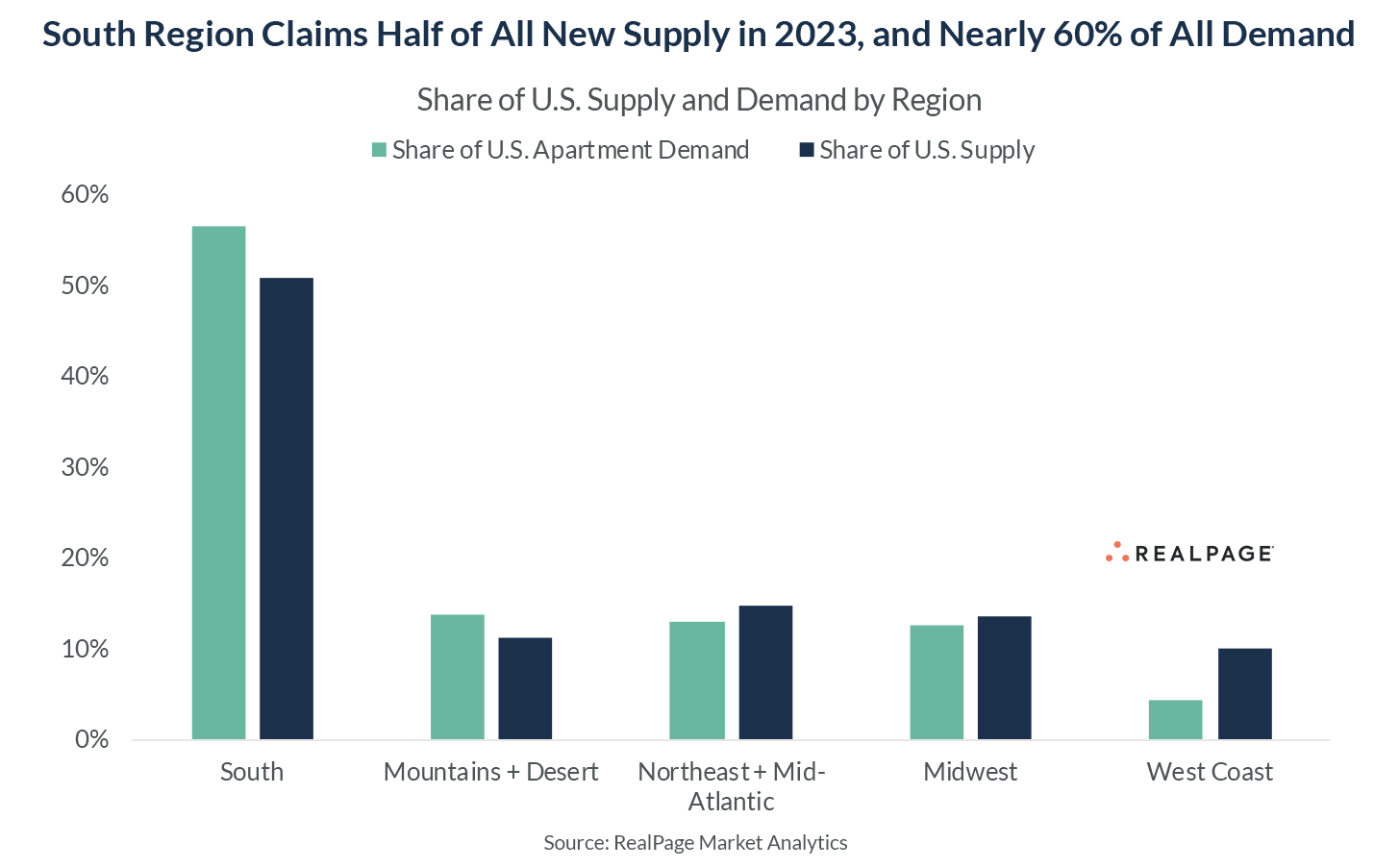Apartment Supply Surges to Highest Levels Since the Mid-1980s

Apartment supply jumped to a 36-year high in 2023, resulting from construction projects that started back when occupancy rates and rent growth were around record highs. But by the time those projects completed, their operators faced a very different leasing environment.
Nearly 440,000 apartment units completed in 2023, and even more are scheduled to deliver in 2024, according to RealPage Market Analytics. After that, completions will dramatically plunge due to the recent slowdown in starts linked to higher financing costs and softer fundamentals.
High supply is great news for renters and a hurdle for investors. Renters suddenly have far more options than they’ve had in recent years, and that’s putting downward pressure on rent growth. Rents flattened in 2023 following back-to-back years of high rent growth.
The upside: Following a sluggish 2022, apartment demand rebounded in 2023 thanks to cooling inflation (including rents) and improving consumer confidence. In particular, 4th quarter – normally a seasonally slow leasing period – turned out to be a surprise bright spot. Net absorption totaled 58,200 units, meaning there were 58,200 more occupied apartments than in the previous quarter. That was the third-strongest 4th quarter in 25 years, topped only by 2020 and 2021 – and by a wide margin.
Net absorption in calendar 2023 came in at 234,000 units, just one-third of the blistering all-time high set in 2021, yet more similar to pre-COVID norms.
While that’s a strong demand tally by any measure, it wasn’t enough to keep pace with supply surging to the highest levels since 1987. As a result, apartment occupancy dropped 80 basis points (bps) year-over-year to 94.1% – still within the long-term normal range, even if much lower than the peaks of 2021-22.
And rent growth evaporated due to more supply than demand. Same-store effective rents inched up just 0.3% in 2023. That ranked the second-weakest performance for any calendar year since 2009, topped only by the pandemic year of 2020.
Notably, though, rent growth levels are no longer decelerating. Year-over-year rent growth topped out at 15.7% in March 2022, and plunged downward from there until hitting 0.3% in August 2023. It’s held around that mark for five consecutive months. Even in most markets cutting rents, the pace of rent cuts hasn’t further deepened.
Furthermore, there remains a clear link between supply and rent change by market. Rents fell in 2023 across 40% of U.S. metro areas – and nearly all of those saw significant new supply entering the market. By comparison, nearly one-third of U.S. metro areas produced rent growth of 3% or more in 2023, and nearly all of them had little supply to work through.
One big question for 2024 is whether rents nationally will continue to hold flat as completions accelerate. Another 671,000 units are scheduled to complete in 2024, after which supply should thin out dramatically. In turn, occupancy and rents should rebound (though not to 2021-22 inflationary highs) in 2025-26.
But in all likelihood, 2024 will bring another year of more supply than demand – adding another challenge for apartment investors also confronting higher expenses and elevated debt costs.
Demand is Going Where Supply is Going
Markets across the Sun Belt and Mountain regions added the most new supply in 2023, as is typical. And the same markets saw the most demand. In fact, the Sun Belt and Mountain regions combined to add 62% of the new supply while claiming 70% of the national apartment demand pie. And in the Northeast and Midwest regions, the supply/demand shares were more balanced.
But on the West Coast, it was a different story. The West Coast took 10% of the nation’s new apartments in 2023, but only 4% of the net new demand. Only one West Coast market – Seattle – ranked among the top 35 nationally for apartment demand.
Of the 12 U.S. metro areas to add at least 7,000 net new apartment households in 2023, all but two were located in the Sun Belt or Mountain region, led by Dallas/Fort Worth, Houston, Phoenix and Austin. The two exceptions were Washington, DC, which ranked #5, and Minneapolis, which finished #10. Also in the top 12: Charlotte, Atlanta, Nashville, Raleigh/Durham, Minneapolis, Denver and Orlando.
Those same 12 markets all ranked among the nation’s top 15 for new supply, along with Northern New Jersey (Newark), Los Angeles and New York. But those three ranked lower when measuring supply by expansion rate, given all three have very large existing apartment stocks.
And that same group of markets is scheduled to rank among the nation’s supply leaders again in 2024.
Rents Continue to Fall in the South and West
While the South dominated the demand leaderboard and the West Coast lagged behind, the two regions were home to most of the nation’s rent cuts in 2023.
In the South, that was largely because of heavy construction putting downward pressure on rents. On the West Coast, supply numbers are lower but they’re still elevated at multi-decade highs in many metros at the same time demand has been tepid.
Across the country, there remained a clear correlation: Rents slow where supply goes.
Florida claimed six of the nation’s 10 largest rent cuts in 2023, primarily due to rapidly rising supply topping still-strong demand. Fort Myers/Cape Coral notched the deepest reduction at -7.9%, with change measured on a same-store basis and inclusive of concessions. Other Sunshine State markets cutting rents at least 4%: Sarasota/Bradenton, Daytona Beach, Jacksonville, Orlando and Palm Bay.
Outside Florida, rents fell 4-6% in Austin, Boise, Atlanta and Phoenix – all high-supply, high-demand markets.
On the West Coast, Portland recorded the deepest rent cut at -3.2%. Rents fell more modestly in most other large West Coast metros. Only Orange County (2.9%) and San Diego (0.6%) saw effective rents increase in 2023.
Rents Keep Growing in the Low-Supply Midwest and Northeast
Not coincidentally, rents continue to increase in low-supply markets. Of the nation’s 150 largest metros, 41 recorded rent increases of at least 3% in 2023. Of those 41, all but seven had supply expansion rates below the U.S. average.
Most of that growth in coming in the low-supply Midwest and Northeast. Of the 50 largest markets in those two combined regions, only two cut rents last year.
By market, Midland/Odessa – the ultimate boom/bust market – continued to lead the way with a 9.7% increase. Seven others topped 5%: Springfield, MA; Rochester, NY; Fargo, ND; Madison, WI; Buffalo, NY; Lexington, KY and Lincoln, NE.
College towns continue to rank among the nation’s rent growth leaders, in part due to very little supply. Most colleges shut down on-campus operations during the 2020-2021 school year, which froze many construction projects at a time when apartment starts were booming in most of the country. And by the time those markets had rebounded, debt costs had jumped so much that construction in college towns never really took off in this cycle.







